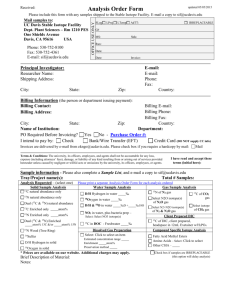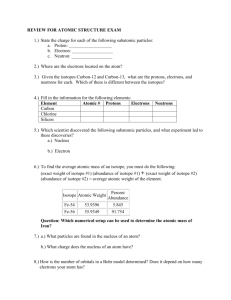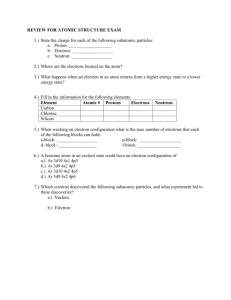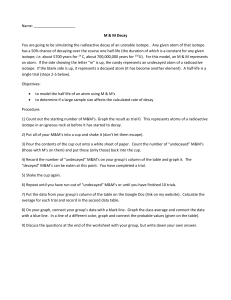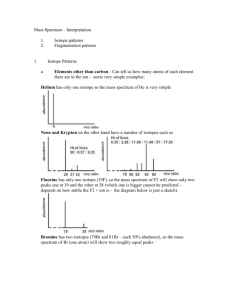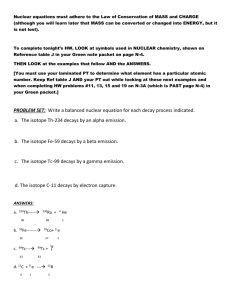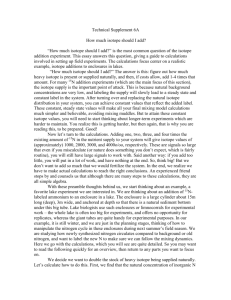Technical Supplement 6B
advertisement
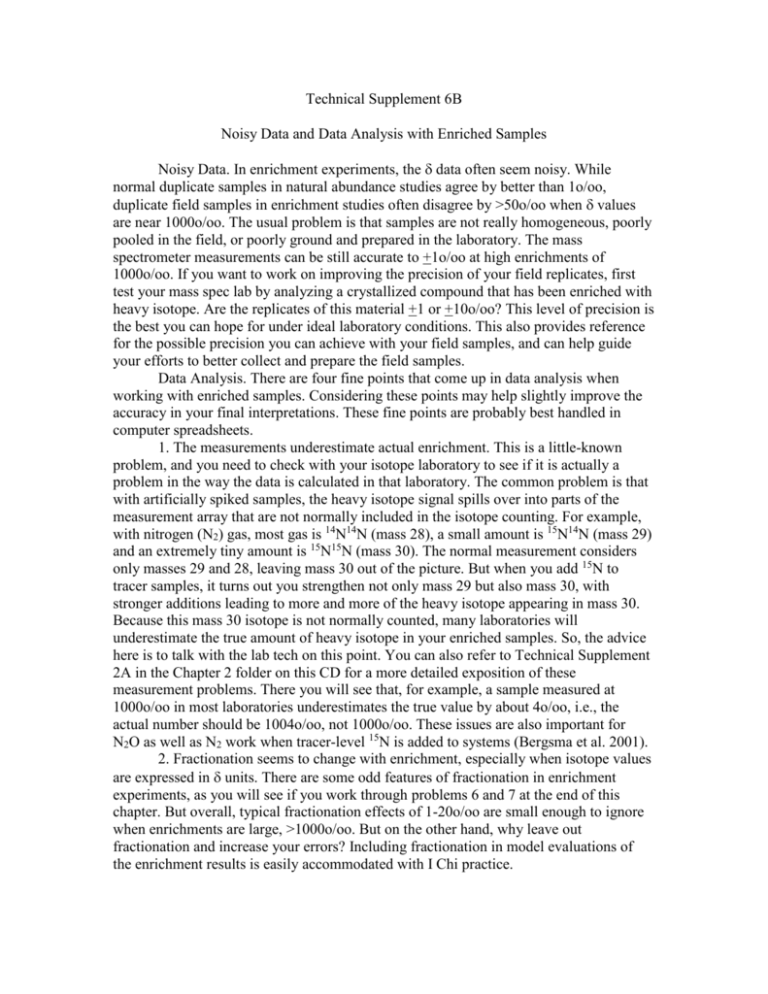
Technical Supplement 6B Noisy Data and Data Analysis with Enriched Samples Noisy Data. In enrichment experiments, the data often seem noisy. While normal duplicate samples in natural abundance studies agree by better than 1o/oo, duplicate field samples in enrichment studies often disagree by >50o/oo when values are near 1000o/oo. The usual problem is that samples are not really homogeneous, poorly pooled in the field, or poorly ground and prepared in the laboratory. The mass spectrometer measurements can be still accurate to +1o/oo at high enrichments of 1000o/oo. If you want to work on improving the precision of your field replicates, first test your mass spec lab by analyzing a crystallized compound that has been enriched with heavy isotope. Are the replicates of this material +1 or +10o/oo? This level of precision is the best you can hope for under ideal laboratory conditions. This also provides reference for the possible precision you can achieve with your field samples, and can help guide your efforts to better collect and prepare the field samples. Data Analysis. There are four fine points that come up in data analysis when working with enriched samples. Considering these points may help slightly improve the accuracy in your final interpretations. These fine points are probably best handled in computer spreadsheets. 1. The measurements underestimate actual enrichment. This is a little-known problem, and you need to check with your isotope laboratory to see if it is actually a problem in the way the data is calculated in that laboratory. The common problem is that with artificially spiked samples, the heavy isotope signal spills over into parts of the measurement array that are not normally included in the isotope counting. For example, with nitrogen (N2) gas, most gas is 14N14N (mass 28), a small amount is 15N14N (mass 29) and an extremely tiny amount is 15N15N (mass 30). The normal measurement considers only masses 29 and 28, leaving mass 30 out of the picture. But when you add 15N to tracer samples, it turns out you strengthen not only mass 29 but also mass 30, with stronger additions leading to more and more of the heavy isotope appearing in mass 30. Because this mass 30 isotope is not normally counted, many laboratories will underestimate the true amount of heavy isotope in your enriched samples. So, the advice here is to talk with the lab tech on this point. You can also refer to Technical Supplement 2A in the Chapter 2 folder on this CD for a more detailed exposition of these measurement problems. There you will see that, for example, a sample measured at 1000o/oo in most laboratories underestimates the true value by about 4o/oo, i.e., the actual number should be 1004o/oo, not 1000o/oo. These issues are also important for N2O as well as N2 work when tracer-level 15N is added to systems (Bergsma et al. 2001). 2. Fractionation seems to change with enrichment, especially when isotope values are expressed in units. There are some odd features of fractionation in enrichment experiments, as you will see if you work through problems 6 and 7 at the end of this chapter. But overall, typical fractionation effects of 1-20o/oo are small enough to ignore when enrichments are large, >1000o/oo. But on the other hand, why leave out fractionation and increase your errors? Including fractionation in model evaluations of the enrichment results is easily accommodated with I Chi practice. 3. Enrichment is expressed as E. In data analysis with enriched samples, one usually expresses the isotope enrichment in a sample vs. a background control. A shorthand way to do this is to subtract out the isotope value of the control, but the better way to make this correction is to use a more complex formula, expressing the enrichment between two samples as the per mille enrichment value, E, where E = [(1 – 2)/(2 + 1000)]*1000 (This equation is derived in the printed Appendix for the book, conversion 1). Example: An isotope-enriched algal sample has a 15N value of 600o/oo and a control sample of this same species has a value of 10o/oo. The value for E is 584.2o/oo, close to, but not the same as the incorrect enrichment value of 590o/oo obtained by simple subtraction (600-10 = 590o/oo). 4. Atom percent. For highly enriched C and N samples whose values exceed about 4,000 and 12,000o/oo, respectively, it is better to use an alternate and more exact notation in mixing calculations, the atom percent notation that can be derived from the notation. Unfortunately, for highly enriched samples, values become increasingly unreliable in the simple mixing equations (Technical Supplement 2A in the Chapter 2 folder on this CD explains this in detail). So, it is better to switch to atom percent that is a direct measure of “% isotope”, and use the atom percent values in the normal mixing equations. Spreadsheets make it easy to convert values to atom percent values, using the following formula derived from the equation (see printed Appendix for the book, conversion 4): atom percent of heavy isotope = + 1000)/[( + 1000+ (1000/RSTANDARD)] where is the measured value, and RSTANDARD is the known isotope ratio of the standard. Example: an aquatic insect from an isotope enrichment experiment has a 15N value of 350o/oo, and two potential foods measure 80 and 700o/oo. What are the source contributions for these two foods? Solution: convert the values to atom % values, using a RSTANDARD value of 0.0036765 for 15N/14N in air N2, the standard for nitrogen work; Table 2.1). Then substitute the atom percent values for value into the two source mixing equation discussed in Chapter 3: f1 = fractional contribution of source 1 = (SAMPLE - SOURCE2)/(SOURCE1- SOURCE2) values for source 1, source 2 and the sample are 80, 700, and 350o/oo respectively, and the corresponding atom % or “%15N” values are 0.39549%, 0.62112% and 0.49388%. The solution is f1 = (0.49388 - 0.62112)/(0.39549 - 0.62112) = 0.5639, the fraction contributed by the 80o/oo source 1, and the fraction contributed by the 700o/oo source 2 is 1- f1, or 0.4361. We can compare this f1 = 0.5639 answer to that obtained with the original values, f1 = (350-700)/(80-700) = 0.5645, finding an almost identical result. So, in this case, using the values in the mixing equation is acceptable. However, in experiments with much higher isotope enrichments, differences between the two methods start to exceed 0.01 in the final fractional result (e.g., for the case when 15N-enriched values are 80, 11500 and 4946o/oo for source 1, source 2 and the sample, respectively, then f1 = 0.5639 when calculated with atom %, but f1 = 0.5739 when calculated with values; the difference in these f1 values equals 0.01). The results based on atom % are always the correct results, and especially as 15N values become larger than 11,500o/oo, calculations should be based on atom %. (Note: for carbon isotopes, the enrichment at which differences in f start to exceed 0.01 is lower, about 3,900o/oo instead of 11,500o/oo. This lower 3,900o/oo value for 13C enrichment is due to a difference in the isotope value of the C vs. N standard used in the atom % calculations. See Table 2.1 for isotope values of these standards). Problems 9 and 10 in the Chpater 6 folder on this CD consider further when to use atom % rather than values for expressing isotope values in tracer addition experiments. Further Reading Bergsma, T.T., N.E. Ostrom, M. Emmons and G. P. Robertson. 2001. Measuring simultaneous fluxes from soil of N2O and N2 in the field using the 15N-gas “nonequilibrium” technique. Environmental Science and Technology 35:4307-4312.
